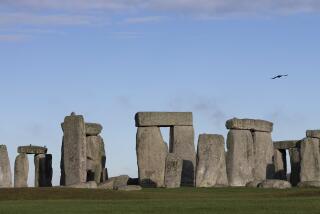Temple Sheds Light on England’s Ancient Builders
- Share via
LONDON — They were rich, tightly organized and gods-fearing farmers at the dawn of history who threw huge religious monuments skyward centuries before the ancient Egyptians raised the Great Pyramids.
Now a major discovery is shedding new light on the convictions and the vision of these early Britons, ancestors of the stone-circle builders who left their most lasting mark at world-famous Stonehenge.
Without setting eyes on it, scholars announced this month that they have discovered the remains of a huge circular timber temple below the hooves of farmer Richard Young’s sheep in a 37-acre pasture near the village of Stanton Drew, about 80 miles north of Stonehenge.
“I think it is certainly among the top 20 archeological finds this century,” said Geoffrey Wainwright, chief archeologist for English Heritage, Britain’s leading conservationist of historic buildings.
The nine-ring wooden temple at Stanton Drew, marked by underground remains of the pits into which 5-ton, 30-foot oak trunks were carefully spaced, is about 5,000 years old.
The vast and elaborate Neolithic structure was 100 yards in diameter and was surrounded by an enormous ditch 15 to 20 feet deep with a large gap facing the northeast. Such structures are named henges after the one at Stonehenge, said Andrew David, an English Heritage specialist who surveyed the site.
Neolithic timber palaces are unique to Britain. The Stanton Drew find is almost twice the diameter of Stonehenge, Wainwright says, and far bigger than any of the other seven previously discovered circular wooden henges.
Neil Linford, an archeological geophysicist who worked on the discovery team, said the temple was found in September thanks to a newly developed and highly sensitive magnetometer, which measures the concentration of iron and oxides underground. In effect, the machine showed the regular pattern of the postholes through residues of rock and decayed wood, Linford said.
*
“Really good geophysical archeology, X-raying the ground before or without digging, is an exciting new development. It is a bit like the dawn of aerial photography in the ‘20s--that’s how the timber temple we call Woodhenge was discovered around 1931,” said Andrew Fleming, a prehistorian at Lampeter University in Wales.
The postholes were about 3 feet deep, 3 feet in diameter and 3 feet apart. Neolithic man would have slid a tree trunk into each hole and propped it upright, but the overall structure was too big to have been roofed, Wainwright says.
English Heritage says it may excavate one small area of the site, but no major dig is planned and--there being nothing to see--Stanton Drew is unlikely to draw tourists.
All that is visible above the old wooden foundation holes at Stanton Drew are three stone circles, just as there is evidence, not visible to the naked eye, of a timber temple under the stones at Stonehenge. The temples, clearly, played key roles in early British societies for many centuries.
“Stanton Drew was built about 3000 BC, lasted 300 to 400 years and was replaced by the stone structure which remains there now,” Wainwright said. In history’s timeline, the temple builders were aligning their oaks just after the wheel was invented in Mesopotamia and the sail in Egypt. That was about four centuries before slaves started the Pyramid of Khufu at Giza.
Like all the other circular finds in Britain, the Stanton Drew structure was built exclusively to beseech and assuage deities: It had no role as a dwelling place or fortification.
“We’re dealing with an early agricultural society that recognizes it’s very important to control the supernatural so that they would get sufficient rain for their crops and growth for their herds,” Wainwright said.
At other timber sites, researchers have found the bones of pigs and the remains of flat-bottomed pottery with spiral and geometric motifs, suggesting that sacrifices were offered at the temples.
Each built at the command of a priest-king, the temples testify that their builders had progressed beyond subsistence farming to prosperous agriculture, probably on the basis of cattle husbandry and crops of wheat and barley. There may have been about a million people scattered across Britain when the timber temples were going up.
“One must be impressed with the sheer scale of the new find--the manpower resources, the vision,” Kinnes said.
Timber had to be found, cut with stone tools and transported, and the holes had to be dug. Yet the only free time for peasant farmers is normally during the winter--hardly the time to be thinking of big construction in Britain.
The construction, then, was done when the builders might also have been sowing crops or tending their herds. Specialists read that as evidence that there was plenty of food and plenty of available workers--and peace--among the temple-building tribes.
“It’s a great mistake to think that the people who built this place were rude, untutored, starving individuals,” Wainwright said. “They were very sophisticated.”
Information about the timber temple at Stanton Drew is available from the English Heritage Web site at www.eng-h.gov.uk
More to Read
Sign up for Essential California
The most important California stories and recommendations in your inbox every morning.
You may occasionally receive promotional content from the Los Angeles Times.








